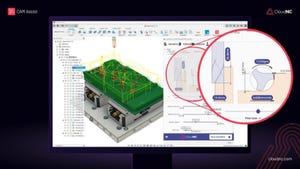Cereplast Commercializes Algae-Based Bioplastic
January 21, 2013

Bioplastic leader Cereplast has successfully commercialized an injection-molding grade of algae-based bioplastics: Biopropylene 109D is made with 20 percent post-industrial algae biomatter, and targets thin-walled applications.
Like many biofuel makers, lots of bioplastics manufacturers are looking for alternatives to using material derived from food-based crops as feedstocks. Shifting to the use of algae is one way of creating sustainable fuels and plastics from feedstocks that don't compete with food crops, or that don't use land that could be growing food crops.
Biopropylene 109D, and the company's other algae-based bioplastics, are designed to replace up to half of the petroleum-based polymers used in traditional resins.
Cereplast, which was one of the first companies to blend algae with a polypropylene, has been working on the technology since 2008, developing and testing algae-filled grades of bioplastics, says chairman and CEO Frederic Scheer in a press release. In 2010, the company announced that it was close to achieving hybrid resins -- blending algae with petroleum-based plastics -- with properties good enough for inclusion in its line of Cereplast Hybrid resins (now the Cereplast Sustainables line).
Biopropylene 109D has a maximum tensile strength of 3,460 psi, a tensile modulus of 240 kpsi, a flexural modulus of 125 kpsi, and a flexural strength of 3,630 psi. (You can access a technical data sheet here.)
Problem-free sources of algae for use in bioplastics have not been easy to come by. The algae produced by typical photo-bioreactors can be used either as a source of biopolymer feedstock raw material, or as biofuel. Cereplast says it has identified a post-industrial source of algae that doesn't rely on the commercialization of biofuel production. Instead, its algae biomass source consists of byproducts resulting from industrial processing to extract specialty chemicals for algae biofuels and nutritionals. The company's R&D team also developed a process for the post-industrial algae source that reduces the algae biomatter's typical strong odor.
The Biopropylene 109D bioplastic is recommended for thin wall injection molding applications. It can be processed on conventional existing hydraulic and electric reciprocating screw injection molding machines. Several customers are currently evaluating the technology.
The company's other bioplastics are based on a variety of biopolymers, including PLA, PHB, PHA, soy protein, or starches from corn, tapioca, or potatoes. In a proprietary process, Cereplast blends the biopolymer with other ingredients to strengthen its molecular structure. That blend is polymerized and its structure reinforced further by treating it with nanocomposites.
Cereplast's Sustainables resins combine high bio-based content with traditional plastic's durability and endurance. They are targeted to applications in industries such as automotive, consumer electronics, and packaging. The company's other product line, its Compostables resins, are aimed at single-use applications, such as food service products.
Related posts:
About the Author(s)
You May Also Like
.jpg?width=300&auto=webp&quality=80&disable=upscale)


